Georgia’s backyards, woodlands, and fields are full of birds that bring life and color to every season. Whether you’re listening to the cheerful calls of a Carolina Chickadee on a winter morning or spotting a bright Northern Cardinal in summer, these familiar species are part of daily life across the state. Some birds, like the Brown Thrasher, Georgia’s state bird, are known for their musical voices and secretive habits among dense shrubs.
Others, including Blue Jays and American Crows, are bold and curious, never shy about announcing their presence. From quiet moments watching a Mourning Dove on a fence to the excited chatter of a flock of goldfinches, learning to recognize these birds can make time outdoors feel richer and more rewarding. This article will help you get to know some of Georgia’s most common birds, offering tips on where to find them and how to tell them apart.
1. Northern Cardinal
- Scientific name: Cardinalis cardinalis
- Life span: 3–15 years
- Size: 21–23 cm / 8.3–9.1 in
- Weight: 42–48 g / 1.5–1.7 oz
- Wingspan: 25–31 cm / 9.8–12.2 in
- IUCN Status: Least Concern
- State status: Breeding and common
- Migration pattern: Stays year-round; does not migrate.
The Northern Cardinal is a familiar sight across the eastern United States, including Georgia’s woodlands and backyards. Males are a vivid red with a tall crest and a bold black mask around their thick orange bills. Females have a more subtle beauty, with warm tan feathers tinged with soft red on their wings and tail. Both sexes have a confident presence, perching openly to sing rich, whistling songs that brighten winter mornings and summer evenings alike.

Northern Cardinals build open cup nests low in dense shrubs or saplings, usually well-hidden among branches. The female weaves a tidy structure from twigs, grasses, and bits of leaves while the male stays nearby, singing loudly to defend the territory. Pairs often raise two or three broods each season. Even when hidden, their bright colors and clear whistles give away their presence, and it’s common to see the male delivering food to the nest or perched watchfully above it.
They feed mainly on seeds and fruits, using their strong, conical bills to crush sunflower seeds, berries, and grains. During the breeding season, they also hunt insects and caterpillars to feed their growing chicks. Cardinals frequently visit feeders stocked with black-oil sunflower seeds and can be spotted foraging on the ground beneath shrubs or along woodland edges, where they find fallen seeds and small fruits hidden in leaf litter.
Northern Cardinals were once less common in the northern parts of their range but have expanded steadily thanks to widespread backyard feeding and suburban landscaping with dense shrubs. Their populations are stable and secure across Georgia. Protected under the Migratory Bird Treaty Act, they remain a cherished symbol of southern woodlands and neighbourhoods, celebrated for their beauty and year-round songs.
2. Blue Jay
- Scientific name: Cyanocitta cristata
- Life span: 7 years on average
- Size: 9–12 in (22–30 cm)
- Weight: 2.5–3.5 oz (70–100 g)
- Wingspan: 13–17 in (33–43 cm)
- Status: Least Concern
- State status: Breeding and common
- Migratory behaviour: Year-round resident; occasional short-distance movements.
Blue Jays live throughout the eastern and central United States, including all of Georgia’s wooded neighbourhoods and forests. Their striking plumage combines bright blue wings and tails with black barring and white highlights.
A tall crest crowns their heads, and a dark necklace runs across their throat. Blue Jays are intelligent and bold, often gathering in noisy groups. In flight, their rounded wings and strong, direct movement make them easy to pick out as they cross open spaces or explore treetops.
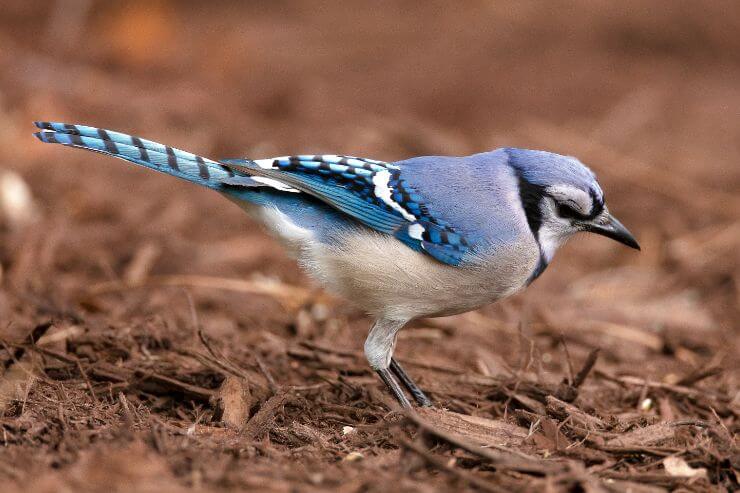
Blue Jays nest in trees, usually 10–25 feet high, often in forks of sturdy branches. Both sexes build the nest, weaving twigs, bark strips, and moss into a substantial cup lined with softer material. They guard their territory aggressively, calling loudly and mobbing predators. Jays often return to the same territory each year, announcing their presence with harsh calls and vivid displays. Their nests blend well into the canopy, hidden despite their noisy behaviour nearby.
They eat nuts, acorns, insects, and occasional small vertebrates. Blue Jays are famous for caching acorns and other food items, burying them to retrieve later in winter. You can often see them carrying several acorns in their throat pouches. Around feeders, they take sunflower seeds and peanuts. Their varied diet helps them thrive in forests, parks, and suburban neighbourhoods. They watch carefully for predators while foraging in groups, giving alarm calls when danger appears.
Blue Jays remain widespread and secure across Georgia. Their habit of planting acorns by caching helps regenerate oak forests naturally. They are protected by law, though no special conservation measures are needed beyond preserving mature trees and diverse woodland habitats. Public education emphasizes their ecological role and intelligent behaviour, which makes them a favourite among bird watchers.
3. American Crow
- Scientific name: Corvus brachyrhynchos
- Life span: 7-8 years
- Size: 16-21 inches (41-53 cm)
- Weight: 11-21 ounces (315-595 grams)
- Wingspan: 33-40 inches (84-102 cm)
- Status: Least Concern
- State status: Breeding and common
- Migratory behaviour: Stays year-round; no large migrations.
The American Crow is one of the most widespread and adaptable birds in North America, found year-round across Georgia. Entirely black from bill to tail, crows have glossy feathers that can look purple in bright sun. Their large, powerful bills and confident stride give them an unmistakable presence.
Crows are intelligent and social, gathering in family groups that communicate with a variety of caws and rattles. They are as comfortable in farmland and forests as in suburban backyards.
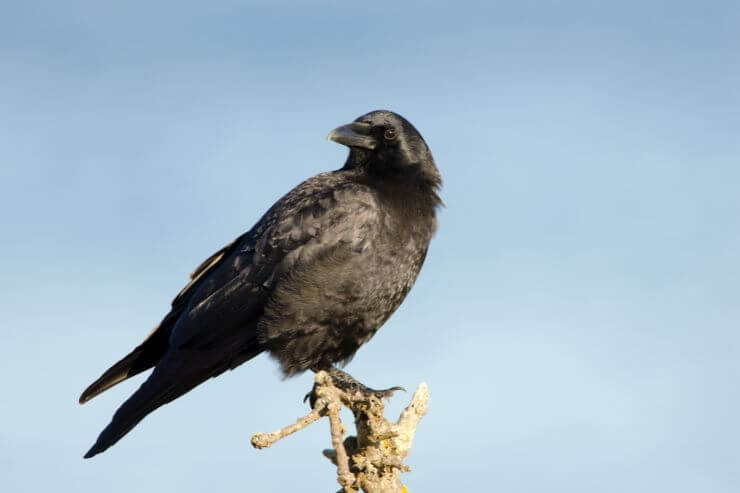
American Crows build bulky stick nests high in trees, often in the largest branches near the trunk. Both adults gather twigs and line the deep cup with softer materials like bark, grass, and animal hair. They are highly protective of their nest area, mobbing hawks, owls, or any intruder. Family groups sometimes help feed the young, strengthening bonds among related birds. They return to the same general territory each year.
They eat a wide variety of foods, including insects, seeds, carrion, and human scraps. Crows forage confidently in fields, along roadsides, and in suburban yards. They probe soil for grubs or pick over garbage when opportunities arise. Their intelligence shows in their problem-solving skills, using tools, dropping nuts onto roads to crack them, and remembering good foraging spots. They often travel in small family groups, keeping watch as they search for food.
American Crow populations remain healthy and secure in Georgia. Although West Nile Virus caused declines in the early 2000s, numbers have rebounded steadily. Conservation focuses on monitoring disease impacts and maintaining diverse habitats. Their adaptability has made them one of the most successful and widespread birds across both urban and rural landscapes.
4. Mourning Dove
- Scientific name: Zenaida macroura
- Life span: 2–5 years
- Size: 9–13 in / 23–33 cm
- Weight: 4–6 oz / 112–170 g
- Wingspan: 17–18 in / 43–46
- Status: Least Concern
- State status: Breeding and common
- Migratory behaviour: Mostly resident; some local movements in winter.
Mourning Doves are common throughout North America and are familiar visitors across Georgia. Their soft gray-brown plumage blends into fences and rooftops, while a delicate pink wash often colors their breast. Long, pointed tails edged in white create a graceful shape in flight. Mourning Doves have a calm, gentle presence and are often seen perched quietly or walking slowly along the ground. Their soft, mournful calls drift across yards and open spaces, giving them their memorable name.
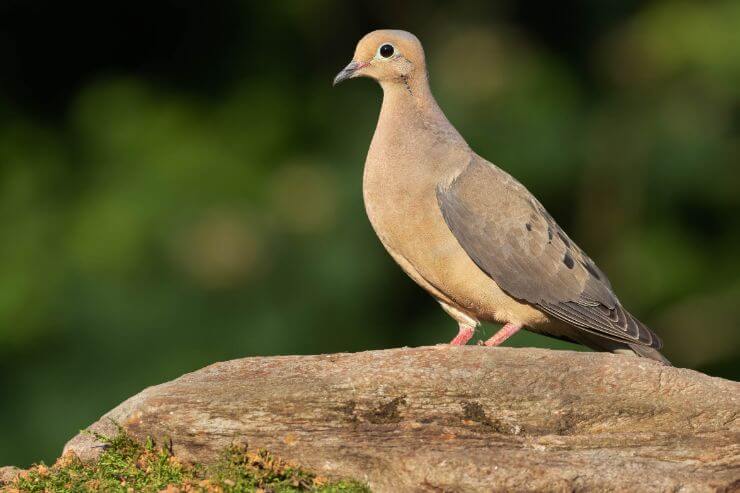
Mourning Doves build fragile platform nests of twigs, usually on horizontal branches, sheltered ledges, or even hanging flowerpots. Females construct the nest while males bring materials, and the finished structure often looks so sparse that eggs show through. Despite this, the nests can support multiple broods each season. Doves are calm and tolerant around people, nesting near houses and farm buildings as well as in woodland edges.
They eat seeds almost exclusively, foraging quietly on the ground in fields and along roadsides. Mourning Doves pick up seeds one by one and store them in their crop before flying to a safe perch to digest. In suburban areas, they visit feeders with cracked corn and millet. Their gentle presence and soft calls make them familiar in nearly every type of habitat, from urban lawns to rural farmland.
Mourning Doves are among North America’s most abundant birds. Managed hunting seasons regulate harvest, while their adaptability ensures populations stay robust. They are protected under federal law, with conservation efforts focused on habitat stewardship and monitoring harvest numbers. Because they thrive in both agricultural and suburban landscapes, they remain secure across Georgia.
5. Carolina Chickadee
- Scientific name: Poecile carolinensis
- Life span: 10-12 years
- Size: 11.5-13 cm (4.5-5.1 in)
- Weight: 9-12 g (0.32-0.42 oz)
- Wingspan: 5.9-7.9 in (15-20 cm)
- Status: Least Concern
- State status: Breeding and common
- Migratory behaviour: Resident all year; never migrates.
Carolina Chickadees are found throughout the southeastern United States, including most of Georgia. They have a smooth black cap and throat, contrasting with bright white cheeks and pale gray underparts. Their compact, rounded bodies and active movements make them easy to recognize as they flit quickly through branches. Chickadees often travel in small groups, chattering in high, cheerful voices. Even in winter, their curiosity and energy make them a lively part of the forest and backyard scene.
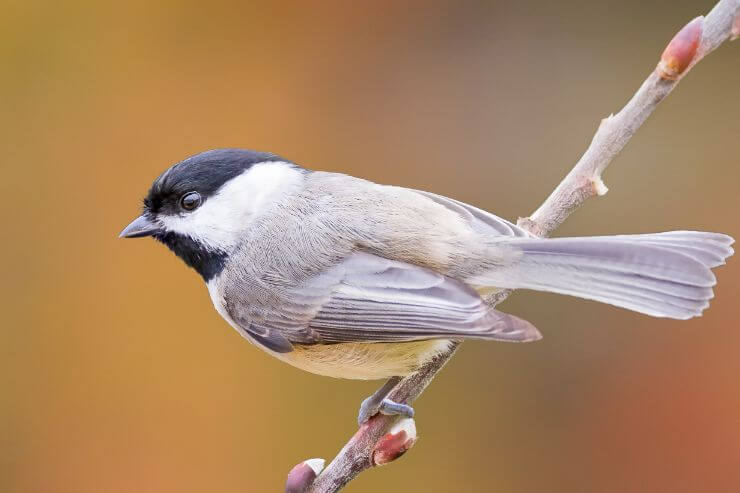
Carolina Chickadees nest in old woodpecker holes, natural cavities, or nest boxes. Pairs excavate rotten wood if necessary, then fill the bottom with moss and line it with animal fur to create a soft cradle for eggs. The female does most of the work while the male stands guard. These small, curious birds are devoted parents, making frequent trips to bring food to the hidden nestlings tucked safely inside the tree.
They eat insects, spiders, and seeds, hopping quickly along branches and trunks in search of food. Chickadees often hang upside down to inspect the underside of twigs or pick insects from bark crevices. They also store seeds in hidden spots to eat later, remembering exactly where they’ve hidden them. This caching behaviour helps them survive cold snaps when insects are harder to find and makes them common visitors to feeders stocked with sunflower seeds.
Carolina Chickadees are abundant across Georgia’s forests, neighbourhoods, and parks. Because they adapt well to fragmented woodlands and accept nest boxes, their numbers have remained steady. They are protected under federal law, and conservation focuses on maintaining mature trees and snag habitat. Citizen scientists contribute valuable data on chickadee populations through backyard monitoring programs and breeding bird surveys.
6. Red-Bellied Woodpecker
- Scientific name: Melanerpes carolinus
- Life span: Up to 15 years
- Size: 9 to 10.6 inches (23 to 27 cm)
- Weight: 2 to 3.2 ounces (57 to 91 grams)
- Wingspan: 13 to 16.5 inches (33 to 42 cm)
- Status: Least concern
- State status: Breeding and common
- Migratory behaviour: Year-round resident; does not migrate.
Red-bellied Woodpeckers are common in woodlands and neighbourhoods across the eastern United States, including Georgia. They have pale gray faces and underparts, with a distinctive red cap and nape that extend down the neck. Their backs are covered in fine black-and-white barring, creating a striking pattern. Though their name suggests a red belly, the colouring is usually faint. Red-bellied Woodpeckers climb tree trunks with ease, calling in loud, rolling notes that echo through the trees.
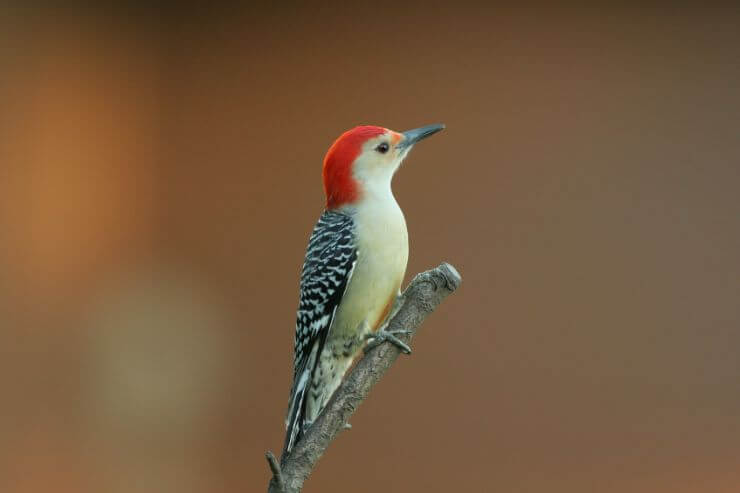
Red-bellied Woodpeckers excavate nest cavities in dead trees or large limbs, often reusing the same site for multiple years. Males do most of the excavation, while females help line the cavity with wood chips. Both parents feed the nestlings, bringing insects and other food back to the hidden chamber. Their rolling calls and drumming announce territory to neighbours and potential rivals.
They eat insects, nuts, fruits, and sap. Red-bellied Woodpeckers climb tree trunks and large branches, probing bark crevices for beetle larvae and ants. They also visit feeders for suet, peanuts, and sunflower seeds. In fall and winter, they store food in cracks and holes to retrieve later. Their habit of caching helps them survive cold snaps and food shortages.
Populations are stable and even increasing in many areas of Georgia. They benefit from mature trees in suburban neighbourhoods and woodland edges. Red-bellied Woodpeckers are protected under the Migratory Bird Treaty Act, and conservation focuses on preserving standing dead trees and large limbs for nesting and feeding. Their adaptability makes them one of the most successful woodpeckers in the Southeast.
7. Tufted Titmouse
- Scientific name: Baeolophus bicolor
- Life span: 10-12 years
- Size: 5.5–6.3 in (14–16 cm)
- Weight: 0.6–0.9 oz (17–26 g)
- Wingspan: 7.9–10.2 in (20–26 cm)
- Status: Least concern
- State status: Breeding and common
- Migratory behaviour: Remains year-round; no migration.
The Tufted Titmouse lives year-round in Georgia’s woodlands, parks, and neighbourhoods. It has soft gray plumage above and whitish underparts, with a distinctive pointed crest on its head. A touch of rusty colouring shows under its wings, and dark eyes give it an alert, friendly expression. Often moving with chickadees, titmice call in clear, whistled notes that echo through trees. They pause frequently to look around, always seeming curious about their surroundings and any people nearby.

Tufted Titmice nest in natural cavities, old woodpecker holes, or nest boxes. They line the nest cup with soft materials, often pulling fur or hair from animal carcasses or even live mammals like squirrels. Both parents help feed the chicks, though the female incubates the eggs alone. They are often seen carrying nesting materials in their small bills, hopping briskly along branches with tufts of fur dangling below their bright eyes.
They eat insects, seeds, nuts, and berries. Tufted Titmice search tree branches for caterpillars and beetles or visit feeders for sunflower seeds and peanuts. They frequently take seeds to a nearby branch to hold them steady with their feet and hammer them open. Their calls are clear and whistled, and you’ll often hear them announcing their presence before you spot their quick, active shapes moving through the canopy or the edges of yards.
Titmice are widespread and stable throughout Georgia. They have adapted well to suburban areas with mature trees and wooded parks. They are protected under the Migratory Bird Treaty Act. Providing nest boxes and preserving dead trees help maintain healthy populations. Citizen science projects and local bird counts have contributed greatly to understanding their habits and distribution across the Southeast.
8. American Goldfinch
- Scientific name: Spinus tristis
- Life span: 3-6 years
- Size: 4.3–5.1 in (11–13 cm)
- Weight: 0.39–0.71 oz (11–20 g)
- Wingspan: 7.5–8.7 in (19–22 cm)
- Status: Least Concern
- State status: Breeding and common
- Migration pattern: Many stay; some migrate south in winter.
The American Goldfinch ranges widely across the United States and is a frequent visitor to Georgia during all seasons. Males are bright yellow in summer, with black wings and a small black cap that highlights their vivid color. Females are more muted, wearing soft olive and yellow shades that blend into fields and gardens. In winter, both sexes turn duller but keep their cheerful, bouncing flight. Goldfinches often gather in small flocks, adding life to weedy fields and feeders.
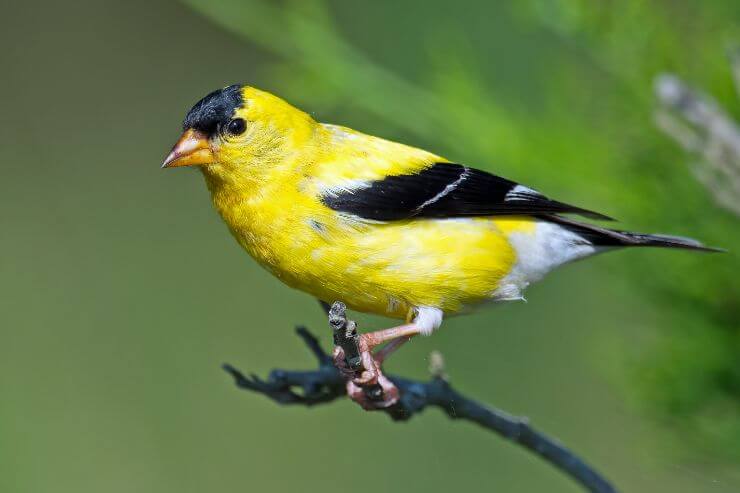
American Goldfinches nest later than most birds, waiting for thistles and other plants to produce down for lining their nests. Females build neat, compact cup nests anchored to branches in shrubs or small trees. Males sing from nearby perches while the female incubates. Their bright colors and high, sweet calls make them easy to spot when nesting in open edges or weedy fields.
They eat seeds almost exclusively, especially from sunflowers, thistles, and dandelions. Goldfinches cling to seed heads, pulling out the seeds with quick, delicate movements. They also visit feeders stocked with nyjer and sunflower chips. Unlike many songbirds, they rarely eat insects, even during breeding season. Their cheerful flight and clear, musical calls are common in meadows and suburban gardens.
Goldfinch populations are stable and widespread across Georgia. Because they rely on open habitats and seed-producing plants, conservation focuses on preserving weedy fields and encouraging native plantings. Their bright colors and fondness for feeders have made them popular and well-loved backyard birds, celebrated as a sign of summer abundance.
9. Northern Mockingbird
- Scientific name: Mimus polyglottos
- Life span: 12-14 years
- Size: 8.1–10.2 in (20.5–26 cm)
- Weight: 1.4–2.0 oz (40–58 g)
- Wingspan: 12–15 in (30–38 cm)
- Status: Least concern
- State status: Breeding and common
- Migratory behaviour: Present all year; does not migrate.
Northern Mockingbirds are common across the southern United States and are especially familiar in Georgia. Their smooth gray backs and paler underparts are accented by white wing patches that flash in flight. Long tails and slender bills make their silhouette distinctive, especially when they perch upright to sing.
Mockingbirds are famous for their vocal mimicry, weaving the calls of other birds and even mechanical noises into their own elaborate songs. Their confident behaviour often makes them the center of attention.
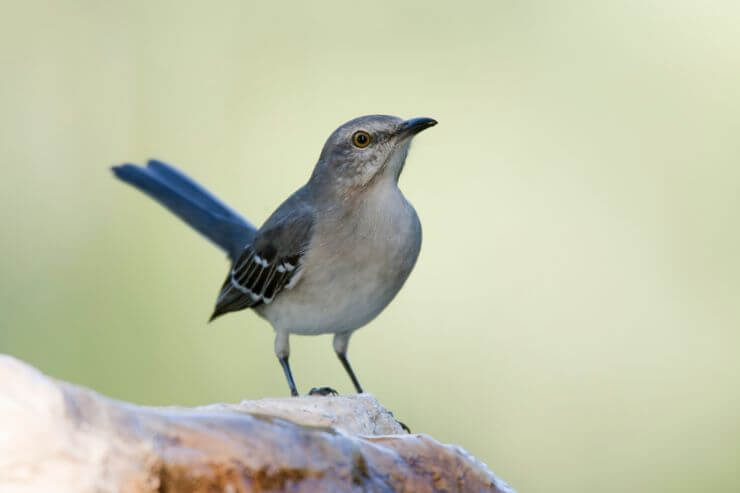
Northern Mockingbirds nest in dense shrubs or small trees, typically 3 to 10 feet above the ground. The female builds a cup-shaped nest of twigs, lined with softer materials like grass and feathers. Males stand watch and sing persistently to defend the territory, often attacking larger birds or even cats that venture too close. Pairs may raise multiple broods in a season, fiercely guarding their chosen site.
They eat insects, fruits, and berries. Mockingbirds often forage on lawns and open ground, running and stopping abruptly to spot insects or collect fallen berries. In summer, they focus on beetles, caterpillars, and ants, while in winter, holly and juniper berries become essential. Their bold behaviour means they aren’t shy about visiting gardens or perching visibly on fences and rooftops to look for food or announce their presence
Mockingbirds are common throughout Georgia. Suburban development with shrubs and ornamental fruit trees has helped their populations remain strong. They are protected under the Migratory Bird Treaty Act. Because they are so adaptable, no targeted conservation is necessary beyond preserving natural cover and planting native berry-producing shrubs.
10. Brown Thrasher
- Scientific name: Toxostoma rufum
- Life span: Up to ~12 years
- Size: 9–12 in (23–30 cm)
- Weight: 2.1–3.1 oz (61–89 g)
- Wingspan: 11–13 in (28–33 cm)
- Status: Least concern
- State status: Breeding and common
- Migratory behaviour: Mostly resident; some northern birds migrate south.
The Brown Thrasher is Georgia’s state bird and is widespread across the southeastern United States. It has rich reddish-brown plumage on its back and wings, paired with bold streaks running down its pale chest. Its long tail often flicks expressively as it moves through low branches or dense hedges.
A slightly curved bill and bright yellow eyes give it a sharp, watchful look. Brown Thrashers are secretive but have one of the most varied and musical repertoires of any songbird.
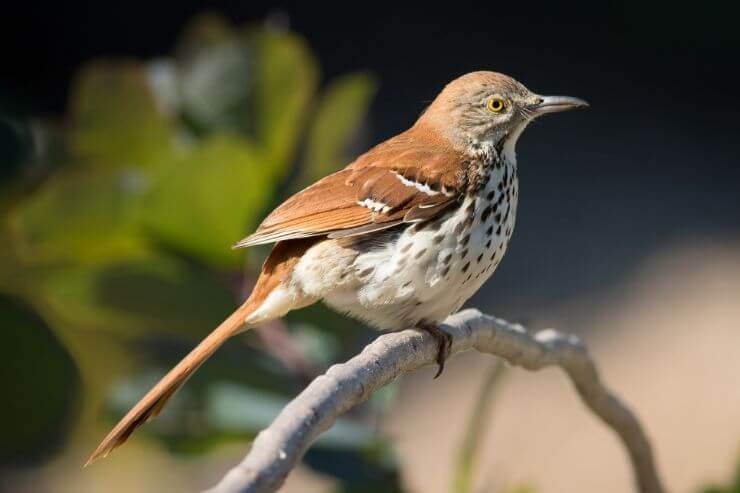
Brown Thrashers nest in dense shrubs, hedgerows, and thickets. Females build a bulky cup from twigs and grasses, usually hidden low and well-protected by foliage. Males sing long, varied songs from prominent perches nearby. Both parents feed the young, and they can be aggressive toward intruders. A pair may raise two broods each season, often reusing the same thick tangle of brambles or brushy thickets close to open spaces.
They eat insects, fruits, seeds, and occasionally small invertebrates. Thrashers forage mainly on the ground, using their long, slightly curved bills to flip leaves and debris aside while searching for beetles, ants, and fallen berries. They move deliberately and watchfully, sometimes pausing to scan for danger before continuing their search. In fall and winter, they rely more on fruiting shrubs, including holly and dogwood, where they can find plenty of berries.
Brown Thrashers are widespread but often stay hidden in dense cover. In Georgia, they remain numerous and secure, benefiting from suburban plantings of hedgerows and wild tangles. They are the state bird and protected by law. Conservation emphasizes preserving shrubby habitat and encouraging homeowners to plant native bushes that provide food and shelter for nesting.
Where to look for Common birds in Georgia
Georgia offers countless places to watch birds, whether you’re exploring pine forests, strolling through a city park, or simply standing by a backyard feeder. Early mornings are often the best time to look, when birds are most active and their songs carry across the landscape. Bring a pair of binoculars and move slowly, stopping to listen and scan treetops and thickets for movement or flashes of color.
Northern Cardinals and Tufted Titmice often visit feeders, while Brown Thrashers prefer dense hedges and shrubby edges. Keep an eye out for Blue Jays hopping through oaks and American Goldfinches clustered around seed heads in weedy fields.
Four great spots to see a variety of common birds include Piedmont National Wildlife Refuge, which has mixed hardwoods perfect for woodpeckers and chickadees; Sweetwater Creek State Park, with trails winding through forest and river habitats; Ocmulgee Mounds National Historical Park, where you can see songbirds along open edges; and Phinizy Swamp Nature Park near Augusta, known for its wetland birds and wooded boardwalks.
Conclusion
Georgia’s common birds bring color, song, and life to every corner of the state, from quiet pine forests to busy backyard feeders. Learning to recognize their calls and markings adds a deeper layer of enjoyment to any walk or moment spent outdoors. Whether you’re watching a bright cardinal or listening to a chickadee’s cheerful notes, these birds remind us how much beauty is always close by, waiting to be noticed and appreciated every day.



